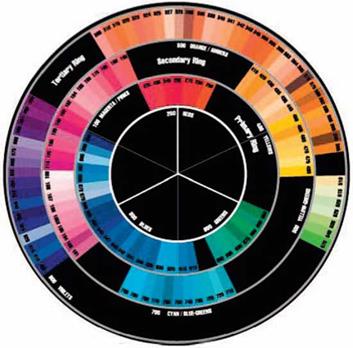Gel filters (Figure 4.3) are used in front of the light source to change what the light is putting out. Lighting designers use gel filters for many different reasons. Gel filters are made of transparent plastic that is heat resistant, and they come in different translucent colors. They should not absorb heat, and are usually made of polyester or polycarbonate. You usually buy them in sheets or rolls. Film people tend toward rolls, theater people toward sheets. Why gels and filters are used and what color is chosen can affect your makeup. There are also digital equivalents of lighting gels and filters created by companies such as GAMPRODUCTS, Inc. with Digital Film Tools. The following explains the color of the gels for photo cameras, film cameras,
video, theatre, and digital add-ins, and what each color is most often used for, as well as how to adjust your makeup to work under these conditions.
General Breakdown of Colored Gel Filters for Light Sources
No-Color Blue: Top light for theatrical daytime. Top light in theatre tends to pale the skin tone. Areas of the face such as the eyes tend to sink or cast a shadow.
Blue Gels: Used most often to match daylight or to suggest nighttime. Can be used to make a light source bluer, and also used with other gels to achieve specific color temperature. If used with + or — green, will help correct some fluorescent or discharge sources. Used on lights and

FIGURE 4-3: FILTER COLOR WHEEL
windows. Blue gels, depending on what is being shot, can have a cooling effect on the skin tone and over all the makeup. Reds look like hues of violets and pinks (tints). Blues and blue greens tend to fade. Lipsticks appear darker.
Grey Gels: Used on lights where color temperature and sharp shadow or patterns must be maintained. Works as a neutralizer and will also neutralize your makeup colors.
Orange Gels: If used with appropriate amount of + or — green, will help correct some fluorescent of discharge sources, and can also be used to simulate sunlight. Use on light or windows. Makeup colors stay the same, but try not to layer with too many warm tones, which could create an orange face. If the person has a ruddy skin tone, add green to your makeup.
Yellow Gels: Fills for sunlight and to warm a room. Makeup stays the same, but if the person has sallow skin, use violet to add life.
Yellow Gold Gel: Warm tones, enhances skin tones. Makeup stays the same. If you have golden undertones in the skin, all the warm colors will work. If you have cool undertones, blue greens and red violets look nice.
Peach Gel: Can be used to make a light source more orange. Will enhance skin tone. Makeup stays the same. A flattering color for all skin types. Used most often for video or close-up beauty shots.
Red Gels: Used for sunsets, sunrises, fires, and to add contrast. Red fades most of your
makeup. Lips appear much lighter. Greens will look darker, and violets will look black.
Good to create contrast. Used most often for theatre or specialty film.
Green Gels: Used to match the green spike in fluorescent lights or discharge. Also can be used with other gels for color effect.
Used on lights, windows, and to contrast.
All green colors will fade. Blushers all but disappear. Lips look dark, so a lighter and brighter lipstick works. The warm tones in red orange, orange, and yellow orange look good. Blues will take on a blue green
53
tone. ——-
